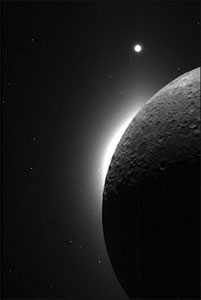Model helps search for moon dust fountains
By Bill Steigerwald, NASA Goddard Space Flight Center | 18 Jun 2010
In exploration, sometimes you find more than what you're looking for, including things that shouldn't be there. As the Apollo 17 astronauts orbited over the night side of the moon, with the sun just beneath the horizon right before orbital "sunrise," Eugene Cernan prepared to make observations of sunlight scattered by the sun's thin outer atmosphere and interplanetary dust from comets and collisions between asteroids. The idea was to have the moon block the brilliant direct sunlight so this faint glow, called Coronal and Zodiacal Light (CZL), could be seen. They should have seen a dim "hump" of light in the middle of the horizon that gradually grew in size and intensity until it was overwhelmed by sunrise. What came next was not supposed to happen.
 |
| This is a picture of coronal and zodiacal light (CZL) taken with the Clementine spacecraft, when the sun was behind the moon. The white area on the edge of the moon is the CZL, and the bright dot at the top is the planet Venus. Credit: NASA |
Cernan did see the CZL glow, but it had a strange companion. A slim crescent of light appeared all along the horizon, and just before sunrise, faint rays appeared, similar to the columns of light seen on Earth when sunlight pokes through a hole in a layer of clouds. On Earth, the horizon glow seen at sunrise and sunset, and the rays, are created when sunlight scatters off atmospheric moisture and dust. But the moon has almost no atmosphere - its atmosphere is so thin, atoms and molecules there rarely collide with each other and it's technically referred to as an "exosphere". This thin atmosphere should not have produced the horizon glow seen.
The sighting during Apollo 17 was not just a one-time freak event. "Similar sightings were reported on Apollo 8, 10, and 15 during planned observations of coronal and zodiacal light," says Dr. Timothy Stubbs of NASA's Goddard Space Flight Center, Greenbelt, Md., and the University of Maryland, Baltimore County.
"Lunar horizon glow (LHG) was first observed between 1966 and 1968 by TV cameras aboard the Surveyor landers - robotic precursors to the manned Apollo landings - specifically Surveyor 5, 6 and 7, and possibly Surveyor 1," adds Stubbs. While the Apollo observations detected LHG at high altitudes – extending up to around 100 kilometers (about 62 miles) above the lunar surface, the LHG recorded by the Surveyors was much lower – within about a meter (one yard) of the surface, according to Stubbs.
Deepening the mystery is that LHG was not always seen. "The astronauts on Apollo 11, 12, and 14 did not look for CZL; however, similar CZL observations were made during Apollo 16 by Ken Mattingly, but no LHG or 'streamers' were seen (to his great personal disappointment). Analyses of coronal photographs from Apollo 15 and 17 revealed an 'excess brightness' along the lunar horizon, which was interpreted as LHG produced by sunlight scattering off a high altitude 'dust atmosphere'. Similar photographs taken during Apollo 16 did not contain any excess brightness (consistent with the astronaut observations). This indicates that LHG is a variable phenomenon – sometimes you see it, sometimes you don't," says Stubbs.
While dust can produce a LHG by scattering sunlight, the presence of even an intermittent high-altitude dust atmosphere was unexpected -the moon's exosphere is far too thin for wind to blow and suspend dust. Although the moon is constantly bombarded by meteorites (mostly microscopic) that kick up dust, "the dust concentrations inferred from LHG are much higher than expected from debris ejected by meteorite impacts alone," adds Stubbs.






























